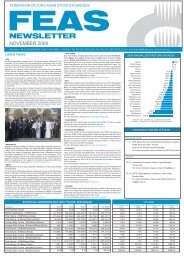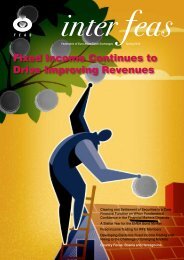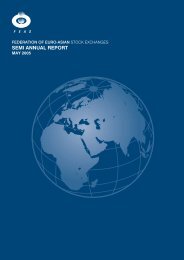Download - FEAS
Download - FEAS
Download - FEAS
You also want an ePaper? Increase the reach of your titles
YUMPU automatically turns print PDFs into web optimized ePapers that Google loves.
FEDERATION OF EURO-ASIAN STOCK EXCHANGES ANNUAL REPORT APRIL 2011<br />
BELGRADE STOCK EXCHANGE<br />
ECONOMIC AND POLITICAL DEVELOPMENTS<br />
Political Developments<br />
Previous year brought some degree of<br />
political stability although the on-going<br />
international economic crisis is bringing many<br />
challenges. The broad coalition that forms the<br />
current Government over the past year<br />
handled a number of serious political issues.<br />
Advancing European integration is a stated<br />
priority of the Serbian Government, and major<br />
progress has been made after the signing of<br />
a Stabilization and Association Agreement<br />
(SAA) in May 2008. Serbia signed and ratified<br />
the SAA with the EU, and in December 2009<br />
officially submitted application for full<br />
membership. In November 2010 a<br />
questionnaire with the comprehensive list of<br />
questions aimed at explaining the country’s<br />
capacity to apply and enforce EU legislation<br />
was handed-over to Sebia. Ahead of<br />
ratification of the SAA by EU member states,<br />
Serbia decided to implement the part of the<br />
agreement related to liberalization of trade.<br />
Nevertheless, the political situation and the<br />
EU accession process in Serbia remain<br />
influenced by recent history related to full<br />
cooperation with the International Criminal<br />
Tribunal for the former Yugoslavia and<br />
Kosovo’s independence. Serbia’s strong<br />
administrative capacity may allow quick<br />
progress towards candidacy status once<br />
political issues are resolved. Serbia is also<br />
pursuing membership in the World Trade<br />
Organization. Negotiation on accession to<br />
WTO are in the final phase.<br />
Accelerating structural reform shall remain<br />
critical to rebalancing the Serbian economy. In<br />
particular, efforts in deregulation and the<br />
restructuring of public utilities should be<br />
stepped up. The multiparty coalition<br />
government, led by the Democratic Party<br />
(DS), could face mounting protests against its<br />
austerity measures.<br />
Economic Developments<br />
Macroeconomic stability has been broadly<br />
maintained although the economy has been<br />
hit by global downturn. The export-led<br />
economic recovery has gained momentum,<br />
but external risks remain significant. GDP<br />
growth is picking up on the back of a<br />
competitive exchange rate and rebounding<br />
industrial output and exports. Growth in 2010<br />
wasl projected at 1½ and 3 percent in 2011.<br />
However, foreign financing risks remain<br />
elevated in the context of a still large trade<br />
deficit and subdued capital inflows. There are<br />
also still significant risks from fresh adverse<br />
spillovers from the region and from euro-area<br />
periphery developments.<br />
The continued depreciation of the dinar is<br />
putting pressure on corporate balance sheets,<br />
but banks remain well buffered. The dinar has<br />
further depreciated since the Greek crisis,<br />
diverging from other flexible currencies in the<br />
region, negatively affecting unhedged<br />
corporate balance sheets. Serbia’s banking<br />
system is liquid and well-provisioned against<br />
credit risks but continued vigilance is needed.<br />
Inflation has surprised on the upside, reemerging<br />
as a key policy concern. Inflation<br />
was consistently below the NBS’ tolerance<br />
band during the first half of 2010. However,<br />
since August 2010, inflation has accelerated<br />
sharply, reaching 8.9 percent in October,<br />
above the NBS tolerance band of 6.3±2<br />
percent. This occurred despite the continued<br />
dampening effect of slow nominal wage costs<br />
growth, owing to a depressed labor market<br />
and the public wage freeze. The NBS has<br />
hiked the policy rate by 250 basis points since<br />
August, and has signaled a continued<br />
tightening bias, with the objective of bringing<br />
inflation within its tolerance band by end-<br />
2011.<br />
In November, the government adopted a 2010<br />
supplementary budget aiming at a fiscal<br />
deficit consistent with the program target. The<br />
2011 budget will target a deficit of about 4<br />
percent of GDP, in line with the new fiscal<br />
responsibility framework. Achieving this target<br />
will require tight control of current spending,<br />
including moderating the indexation of public<br />
wages and pensions, as well as constraining<br />
capital spending. With government financing<br />
becoming more difficult, as evidenced by<br />
undersubscribed dinar T-bill auctions in spite<br />
of higher yields, Telekom privatization<br />
proceeds will likely be needed to cover a<br />
major part of the financing needs. Maintaining<br />
an economic policy consensus will be one of<br />
the most difficult challenges facing<br />
policymakers.<br />
The government amended the pension reform<br />
law. It introduced two changes aimed at<br />
strengthening protection for the most<br />
vulnerable and women. The Serbian pension<br />
system will remain one of the most expensive<br />
systems in the region, and further reforms are<br />
likely unavoidable.<br />
FDI and other inflows to enterprises have<br />
come in significantly lower than expected,<br />
reflecting Serbia’s relatively high country-risk<br />
premium and banks’ concerns about<br />
unhedged corporate balance sheets,<br />
particularly in the nontradable sectors, which<br />
absorbed most of the pre-crisis capital<br />
inflows.<br />
(source: IMF, WB)<br />
Information obtained from the Exchange.<br />
Key Information Contacts<br />
National Bank of Serbia: www.nbs.rs<br />
Securities and Exchange Commission: www.sec.gov.rs<br />
Central Securities Depository and Clearing House: www.crhov.rs<br />
Ministry of Economy and Regional Development: www.merr.gov.rs<br />
PAGE 48
















